San Jose is the largest city in Northern California by both population and area. It is known for its innovation, cultural diversity, mild climate, and sunny days. San Jose is one of the wealthiest major cities in the world, with the world’s third-highest GDP per capita and the fifth-most expensive housing market. There is an extensive network of municipal and regional parks. Kelly Park, located along Coyote Creek, houses a zoo, a Japanese garden, and an outdoor museum of restored and replica buildings from early San Jose.
San Jose flourished and developed rapidly in the 1890s. Paul P. Austin became mayor in 1894. The First Unitarian Church, Hall of Records, Associated Charities, Post Office, and several other major infrastructures were also built in the 1890s.
Here are some stunning historical photos that streets, towns, and everyday life of San Jose in the 1890s. Also check, San Jose in the 1860s, 1870s and 1880s.
#1 San Jose State Normal School, 1895
#2 San Jose Post Office, 1898
#3 Mrs. Winchester’s Bedroom. Winchester Mystery House near San Jose California, 1890s
#4 Chinatown, North Sixth Street, 1897
#5 Welch Children, San Jose, 1896
#6 State Normal School Faculty group portrait, 1893
#7 The Garden City Winery owned by A. Lagna on South Almaden Boulevard, 1890s
#8 Willnettie Ranch, San Jose, 1892
#9 Manual Training Room, San Jose State Normal School, San Jose, California, 1892
#10 Students in front of East San Jose School, located on McLaughlin Avenue, East San Jose, 1892
#11 San Jose & Santa Clara Street railway car, 1890
#12 Members of the San Jose State Normal School Tennis Club, 1893
#13 San Jose State Normal School, 1895
#14 Interior Hammer and Lewis store, 28 North Market Street, San Jose, 1890s
#15 Trolleys in route on the Alameda between Santa Clara and San Jose, 1890
#16 Chinatown, San Jose, 1899
#17 Plaza and San Jose Post Office, 1898
#18 The New Century block or deSaisset building, corner of 2nd and Santa Clara Streets, San Jose, 1890s
#19 East San Jose School, Adams Street near Alum Rock Avenue, 1891
#20 San Jose City Hall, 1890s
#21 Students on the lawn of San Jose State Normal School, 1895
#22 Postcard of Fruit Canning, San Jose, California, 1890s
#23 Start Sunday School Commission in San Jose in 1894
#24 Lincoln School, San Jose, 1898
#25 House Moving, 8th & Empire Sts., San Jose, 1890s
#26 Court House, day Co. B went away, San Jose, 1898
#27 Alum Rock Park, San Jose, California, 1897
#28 Fredericksburg Brewery employees with mugs of beer, 1895
#29 J. R. Welch Home, San Jose, 1896
#30 San Jose storefronts, 1890s
#31 Fredericksberg Brewery Crew, San Jose, 1895
#32 Children with employees of Fredericksburg Brewery, San Jose, 1895
#33 First Presbyterian Church interior, located at 56 North Second Street, 1891
#34 Willow Glen School, Minnesota & Lincoln Avenue, 1897
#35 Fredericksburg Brewery employees, 1895
#36 Man driving in horse-drawn cart down a street, seen from the front. Likely Evergreen, near San Jose, 1920
#37 Auzerais Building, 1890
#38 Hotel Vendome, San Jose, 1892
#39 City Hall San Jose, 1890s
#40 First Unitarian Church of San Jose, 1895
#41 Post Office, San Jose, 1895
#42 Electric Light Tower from First and Santa Clara Street, 1890
#43 John Balbach, Jr’s carriage trimming and painting shop was located on the northwest corner of Market Street and Pierce Avenue, San Jose, 1896
#44 Hayes-Chynoweth Home, Edenvale, 1890
#45 Hotel Metropole building, Northwest Corner of Market Street and Post Street, 1896
#46 Agnews State Hospital, long shot across field from rear-side, San Jose, 1890
#47 Agnews State Hospital, rear side, with gardener and pedestrians, 1890
#48 Agnews State Hospital, front view up new, Palm tree lined drive, 1890
#49 Real Estate office in San Jose, California, 1890s
#50 Fitzpatrick & Kelley, Blacksmithing and Horsehoeing, San Jose, 1890s
#51 Women at the Alum Rock swimming pool, San Jose, 1897
#52 First Methodist-Episcopal Church altar, San Jose, 1894
#53 Agnews State Hospital, close up of side, 1890
#54 Stagecoaches enroute to Mount Hamilton on Alum Rock Avenue near the San Jose Country Club, 1895
#55 Evergreen School, San Jose, 1890
#56 State Normal School, Washington Square, 1896
#57 San Fernando Street Horsecar, 1890s
#58 Street Scene, North First Street., San Jose, 1890
#59 View of downtown San Jose from Courthouse, 1890
#60 St. Aloysius Day Parade, San Jose, 1891
#61 San Jose, Los Gatos, Saratoga Interurban R. R., 1895
#62 Horsecar on The Alameda, 1895
#63 Parade at First and St. John Streets, 1890
#64 Statehouse Replica at Market Street Plaza, San Jose, 1899
#65 Looking down at Market Square/Market Plaza, with the old San Jose Library building and St. Joseph’s Church, 1890s
#66 San Jose High School – Class of 1891
#67 Early San Jose Mercury Newspaper Office, 1890

The space used by the San Jose Mercury is on the right and the space used by the Santa Clara Valley Land Agency is on the left. Both spaces are fronted by long counters with men sitting/standing behind them. More men are standing at the rear of the photograph. This office was located at 171 West Santa Clara Street in San Jose. Office space was shared by these two companies for only a few years.
#68 Roses in garden and on porch, 1895
#69 Post Office on Market Street, 1890
#70 Palace Hotel, San Jose, 1898
#71 Group of San Joseans during the Spanish American War, 1898
#72 St. Patrick’s Church, 1898
#73 Two women and two girls on a house porch, 1890s
#74 woman feeding goat on porch, 1890s
#75 Mount Hamilton stage coach livery, 1892
#76 Southern Pacific Depot, North First Street, 1898
#77 Mangrum & Otter, Plumbing and Hardware; 85 East Santa Clara Street, 1890
#78 Alum Rock Garden, 1897
#79 Building at Golden Gate Park, 1890s
#80 Lick Observatory buildings, 1898
#81 Vennum House on Lundy Road, December 25, 1895
#82 Vendome Hotel, 1895
#83 Vallejo waterfront and ferry, 1890s
#84 Socrates Kirk House on Hicks Rd, 1895
#85 Building set back from the road, with tall trees in front of it. Appears to be a mountain setting, 1892
#86 James H. Campbell Home, 1890
#87 People Preparing for a Stage Ride, 1890s
#88 W. Faulknar Horse Showing & Blacksmithing, 1890s
#89 Steamship at Minticelo, 1890s
#90 Fredericksburg Brewery on the corner of Cinnabar and The Alameda, 1895
#91 Alum Rock Railroad, 1895
#92 American Fish Co., F. Locicero; lots of fowl, 1890s
#93 South First Street, San Jose, 1890
#94 Native Sons of the Golden West Parade, 1890s
#95 Mangrum & Otter Hardwarem, 1892
#96 Garden, Santa Clara College, 1890
#97 Eaton House, 1890s
#98 Alviso School, San Jose, 1895
#99 Singleton Home on Senter Road, 1895
#100 First Street Scene, 1890s
#101 Golden Gate Packing Electrical Co, 1890s
#102 Goodrich’s Sandstone Quarry, 1890
#103 Mount Hamilton Store, 1890
#104 Mountain View School, 1890s
#105 Edenvale Station, 1890
#106 Talladega, Alabama, group, 1896
#107 Fountain counter at drug store, 1890s
#108 Lick Observatory, Mt. Hamilton, Altitude 4200 ft, 1895
#109 possibly the Hellyer Home, 1895
#110 Agricultural scene in Gilroy, 1890
#111 Mayfield School, 1890s
#112 Horse train hauling logs near Mt. Shasta, 1898
#113 Palo Alto Parlor No. 82, N.S.G.W., 1898
#114 Smith Creek hotel, Mt. Hamilton Road, 1895
#115 Mount Hamilton Summit, 1890
#116 Railway express office, 1890s
#117 Grain harvesting operation, 1890s
#118 Bar room scene, 1890s
#119 Benj. Gertaz women’s clothing store, 1890s
#120 Fredericksburg Brewery & Employees, 1895
#121 Man walking in front of building, 1890s
#122 Trolley Barn on The Alameda, near Race Street, 1890s
#123 Watkins Home, Gould Avenue., 1890
#124 College of the Pacific Conservatory of Music interior, 1896
#125 Mount Hamilton stable buildings, 1892
#126 Robertsville Store, Prosper Estrade proprietor, 1890s
#127 Brewery Wagon, 1892
#128 William Lewis Manly residence, 1890s
#129 California State Militia, 1890
#130 Henderson, William home, 1890
#131 Two-story Victorian house, 1895
#132 Mount Hamilton vista, 1892
#133 Engstrom office, 1890s
#134 Crowd outside the Hall of Records, 1898
#135 Mount Hamilton buildings, 1892
#136 Unidentified apartment building, 1898
#137 Company “B” leaving, Broad Gauge Depot, 1898
#138 Mount Hamilton Stagecoach at Grandview House, 1890s
#139 Schiele Avenue, San Jose (California), 1897

A letter from a previous owner (Walter Torbet) that accompanies the letter reads, "In the sixties when my Dutch wife and I were living in San Jose, a Dutch relative sent us the enclosed photo. At the time we checked, and the house was still there. Other than that, I know nothing about the photo. Three children and their parents are standing in the front yard outside a Queen Anne/Victorian style one-story wood-framed house. A rose vine extends the length of the front porch.
#140 Robert F. Peckham Home, 615 East Santa Clara Street, 1890s
#141 East San Jose School Classroom, 1898
#142 San Jose State Normal School, 1895
#143 College of Notre Dame under construction, 1895
#144 St. Aloysius Day Parade, 1891
#145 Robert F. Peckham Home at 615 East Santa Clara Street, 1890
#146 Lick Observatory, 1890
#147 San Jose Monument Works group portrait, 1890s
#148 De Saisset building on corner of 2nd and Santa Clara Streets, San Jose, 1895
#149 First & Santa Clara Streets, 1890s
#150 La Serena Adobe, 1890s
#151 Rea Building, San Jose, 1895
#152 F. F. Butter grocery store, 1898
#153 Leddy Butcher Market, 1890s
#154 View of City Hall, 1893
#155 New Almaden Stage, 1896
#156 Jamison’s Fish & Poultry Market, 1898
#157 San Jose postal employees, 1895
#158 San Jose post office, 1895
#159 San Jose Hall of Records, 1895
#160 Sunday School Parade, 1st. & San Fernando, 1895
#161 San Jose Post Office cornerstone ceremony, 1892
#162 Santa Clara County court house, 1895
#163 First Unitarian Church, 1895
#164 California Jubilee Parade, 1899
#165 California Pioneers of Santa Clara County picnic, 1897
#166 Adobe at Alviso and Santa Clara Street, 1899
#167 Auzerais House, 1890
#168 Gubserville, 1904
#169 The Linda Vista Sanatorium located near Alum Rock Park, 1890s
#170 Alviso Rose Carnival, 1896
#171 Horace Mann School, 1895
#172 Hay Baling, 1891
#173 Twelve Mile House, 1890
#174 Replica of California’s First Statehouse, 1899
#175 San Jose High School, 1898

San Jose's first high school was built at the southwest corner of Seventh and San Fernando Streets. The $100,000 brick-and-stone structure was designed by Jacob Lenzen and Son and included an assembly hall that could seat up to 2000. The new school opened in September 1898 but was destroyed in the 1906 earthquake.
#176 Fire damage in San Jose, 1892
#177 Fire damage in San Jose, 1892
#178 Marching band parading in the street, 1890
#179 Santa Clara Valley Mill & Lumber Co., 1893
#180 View from San Jose City Hall looking north up Market Street, 1895

View from the upper floors of San Jose City Hall looking north up Market Street. The city hall was located in the middle of Plaza Park, now known as Plaza de Cesar Chavez. On the right the tan sandstone building with the clock tower is the San Jose Post Office. Beyond the post office is St. Joseph's Cathedral with its dome and twin spires.
#181 Kensington Post Office, Willow Glen, 1893
#182 Fourth of July Parade, St. James Park, 1890
#183 Mountain Echo Band of New Almaden, 1891
#184 Company B: Camp, Officers of Friendship Lodge No. 210, 1895
#185 Orchard wagon, 1890
#186 Thomas Stone house, 1890
#187 The Rea Building taken from under the Light Tower, 1895
#188 De Soto’s in Hall’s Valley, 1890
#189 Four men in front of Leddy’s Market, 1890
#190 Laurel Station, 1890
#191 Hay Press Crew and Cook, 1892
#192 Sailboat “Wanderer” at Alviso, 1898
#193 The southward view of San Jose City Hall and the plaza, 1895
#194 Guadalupe River flood near Notre Dame College, 1890
#195 Richards’ family parlor,1891
#196 North First Street, 1895
#197 Fredricksburg Brewery, 1890
#198 Rea Building, 1893
#199 State House replica with people on balcony, 1899
#200 Myles P. O’Connor residence, 1890

View of very large two-story house on a corner lot with bare trees lining the streets. This was Judge Myles P. O'Connor's house. It stood at the corner of Second Street and Reed Street. O'Connor later gave the house to the Sisters of Notre Dame de Namur. They used it for an orphanage, the Notre Dame Institute, and then it was used for Notre Dame High School.
#201 State Normal School, 1890

Across a lawn planted with palm trees is the second San Jose State Normal School building. It was built in 1881 to replace the original Normal School building which was destroyed by fire. It was built of brick and stone to in an effort make it more fire resistant and incorporated a 5000 gallon water tank on the third floor. But the brick was unable to resist the strong shaking of the 1906 earthquake and the building was too badly damaged to be repaired. The gray building on the right held elementary school classrooms where student teachers could practice before graduation.
#202 Cattle graze by a stream on the Dunne Ranch near Gilroy, 1895
#203 San Miguel Flour Mill, 1898
#204 Horace Mann School, San Jose, 1890
#205 Twelve Mile House, 1890

The Twelve Mile House was a rest stop on the stage line between Monterey and San Jose. As the name indicates, it was located twelve miles south of San Jose in the Coyote area. Twelve Mile House also served the local population as a general store, saloon, hotel and post office.
#206 Mountain View Railroad Station, 1890s
#207 Mission San Jose School Class, 1893
#208 The Mission San Jose Band of 1895, Organized by its Leader August Sunderer, 1895
#209 Fair Mansion, 1890
#210 Front View of Santa Clara College, near San Jose, 1890
#211 Site of the 1896 McGlincy Murders.
#212 Solon Building Mission San Jose, 1890
#213 Geyser Hotel, Sonoma County, 1890
#214 Mount Hamilton Stage stopped at Smith Creek Hotel, 1897
#215 Mountain View railroad station, 1890
#216 McGlincy house and barn, 1896
#217 Mount Hamilton stage at Lick Observatory, 1890
#218 Several men pose with their bicycles and horses in front of Twelve Mile House and Coyote Store, 1890
#219 California State Capitol replica, 1899
#220 View of City Hall, 1893
#221 St. James Park, 1890
#222 South Second Street looking north, 1890
#223 San José Electric Light Tower, 1895
#224 Hester School, 1892

Hester School, located on The Alameda at Schiele. The 1890 San José City Directory lists teachers as J. M. Allen, Emma Stockton, M. C. Burt, Rosa Denne, Susie W. Rucker, Virginia Calhoun, Olive M. Knox, Ester Summers, and Miss Wood. On display at the Andrew P. Hill House, History Park.




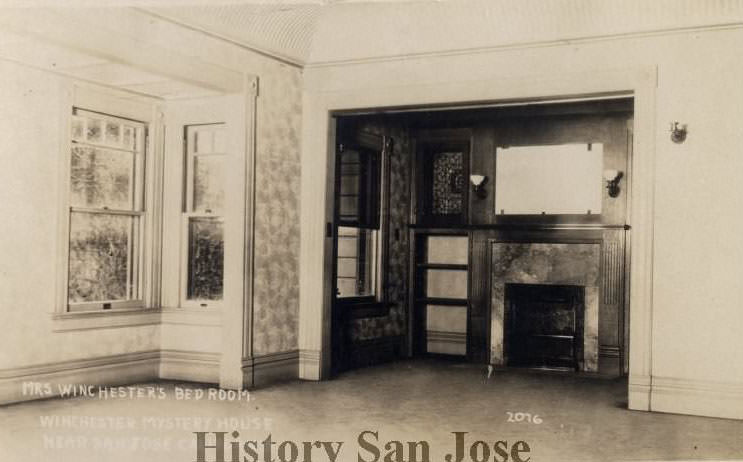





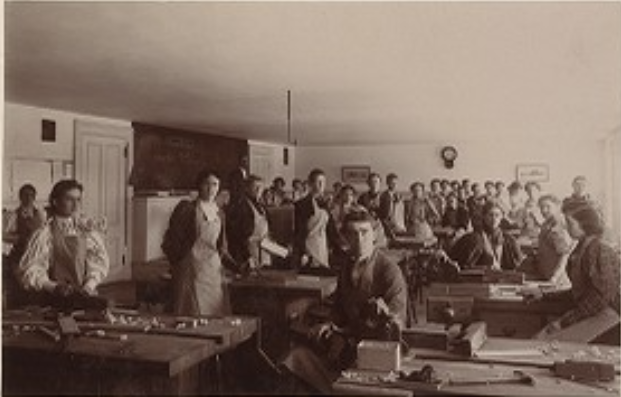





























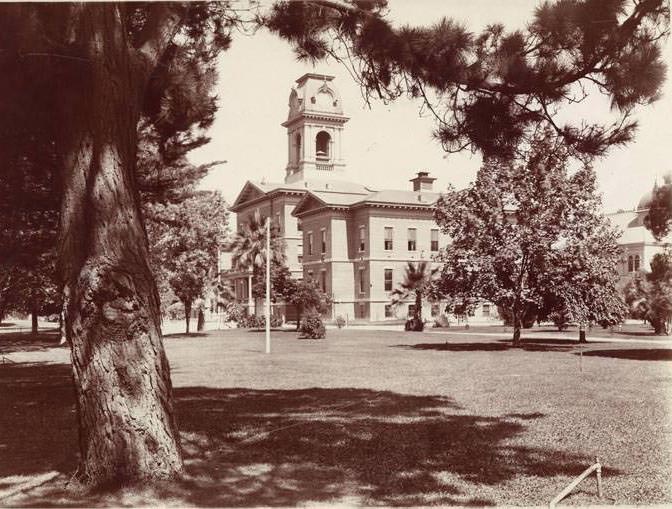














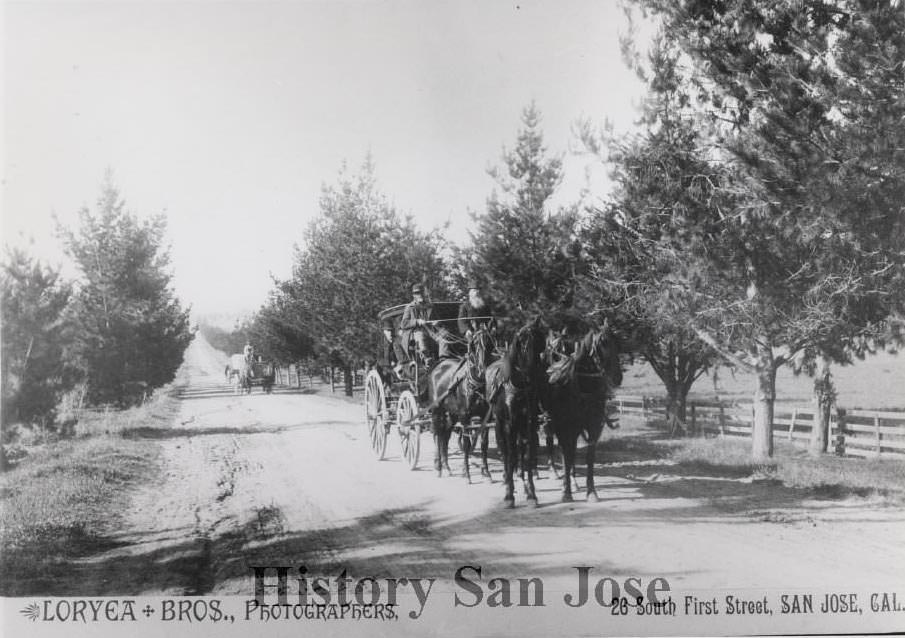
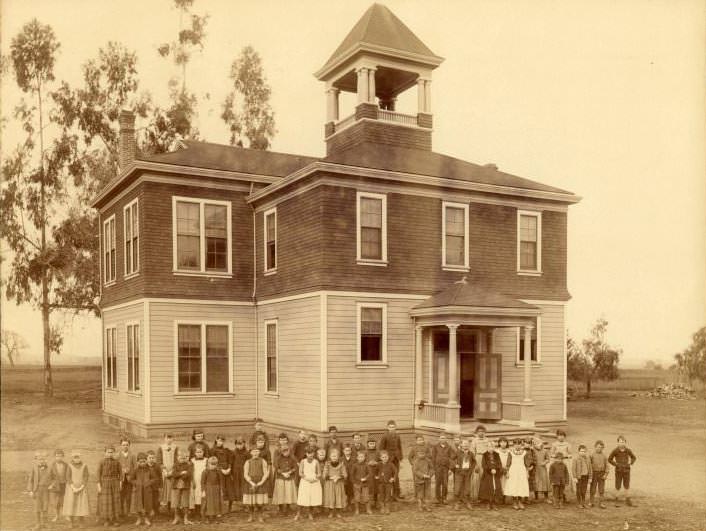




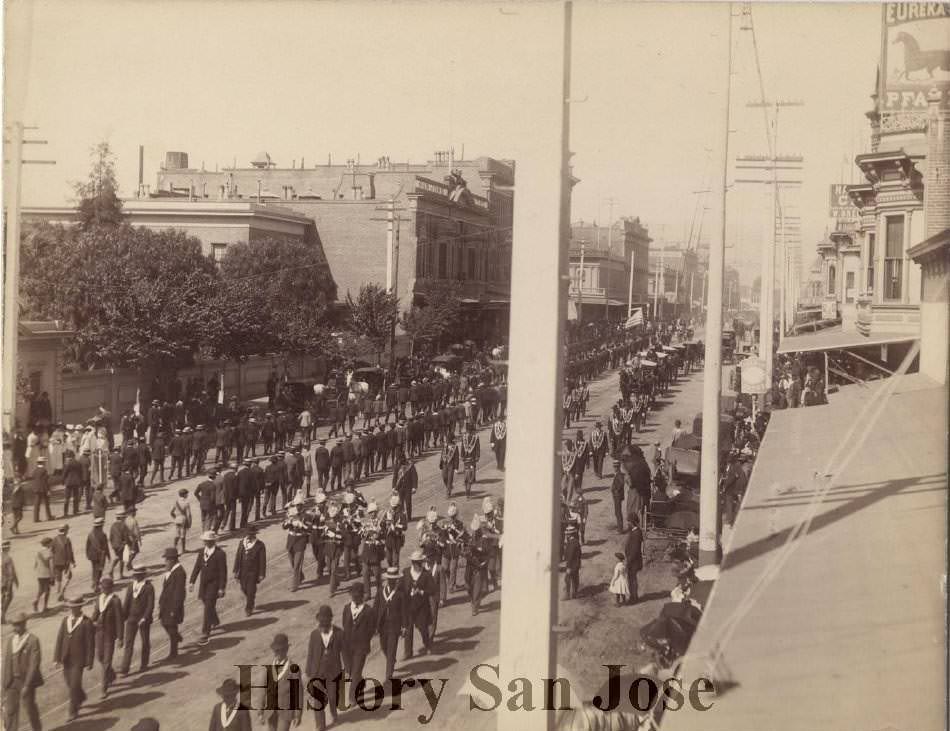








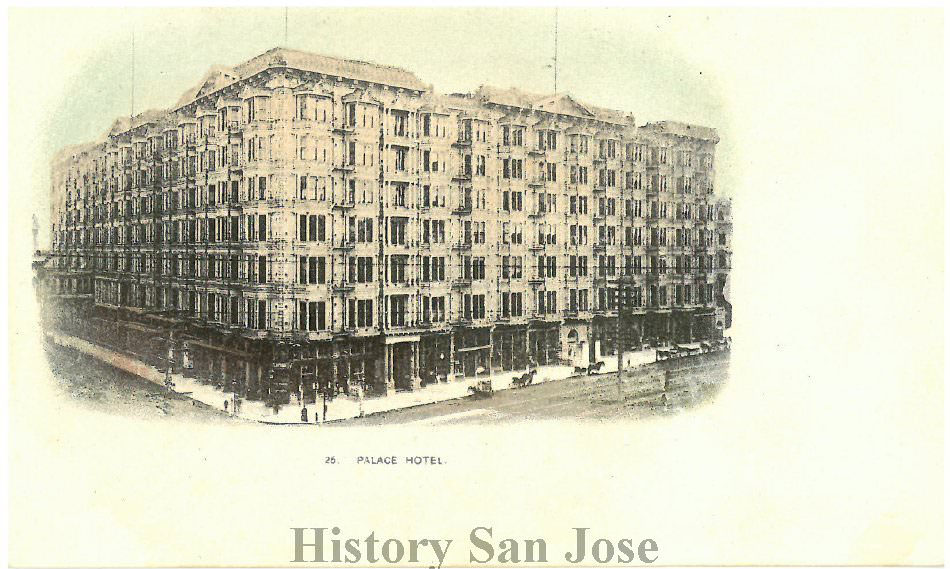






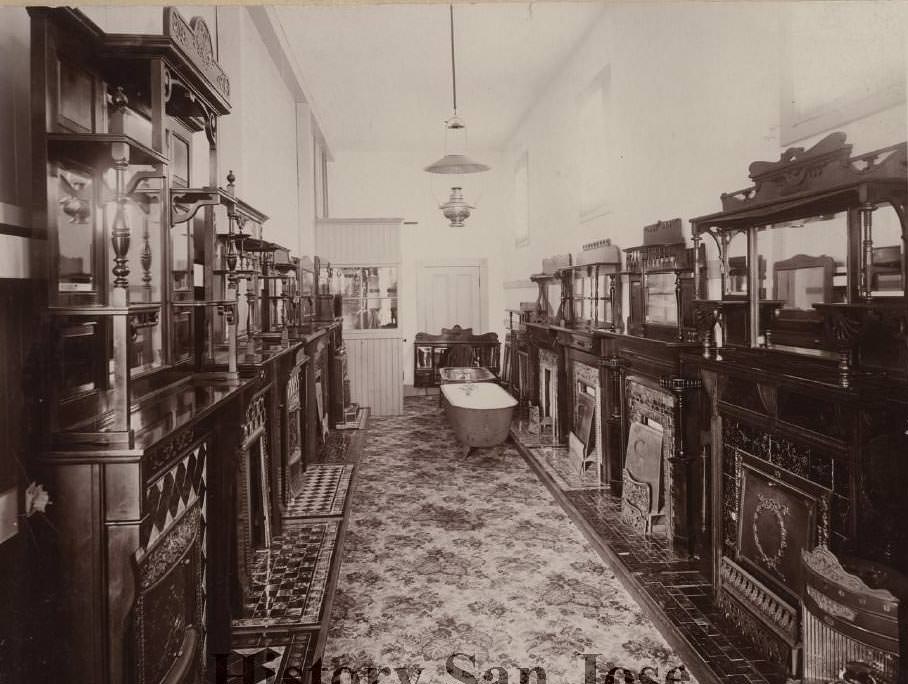




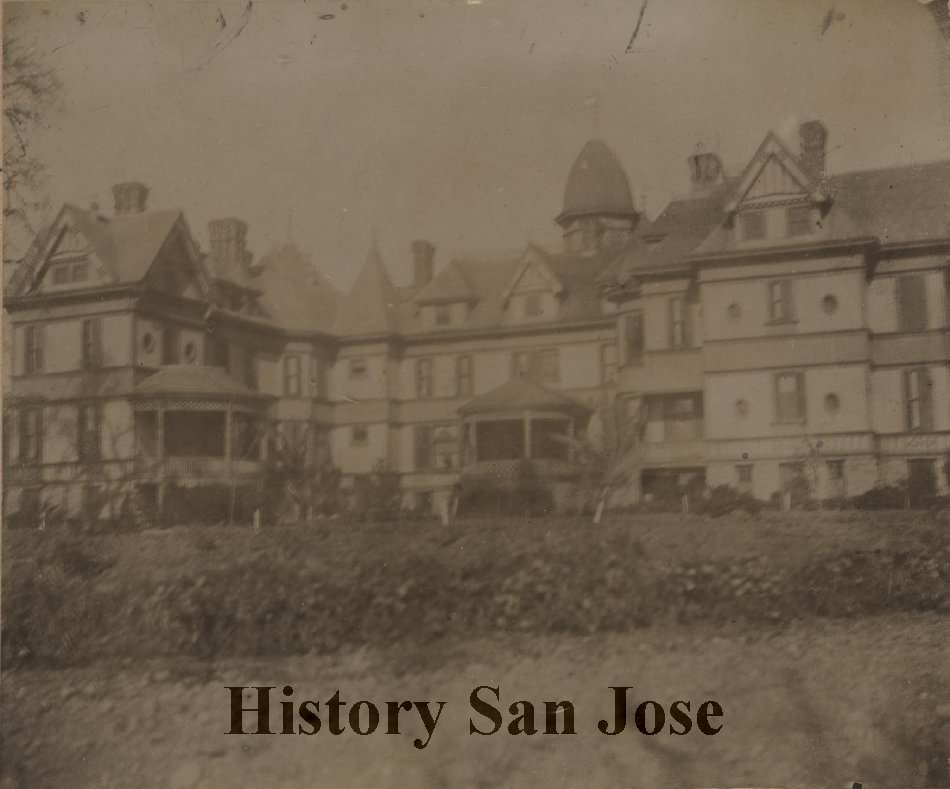







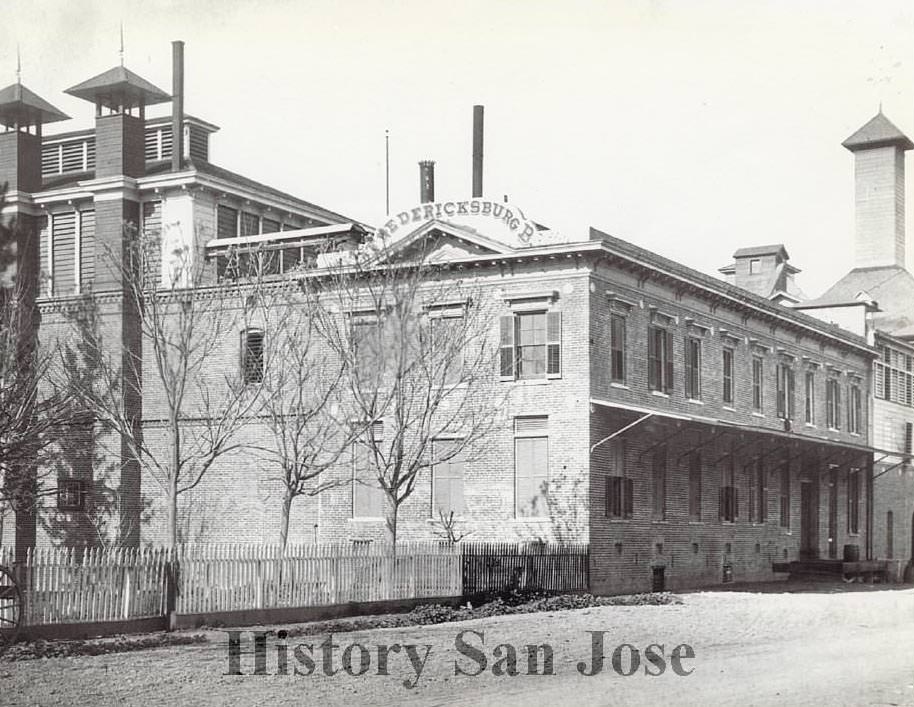

















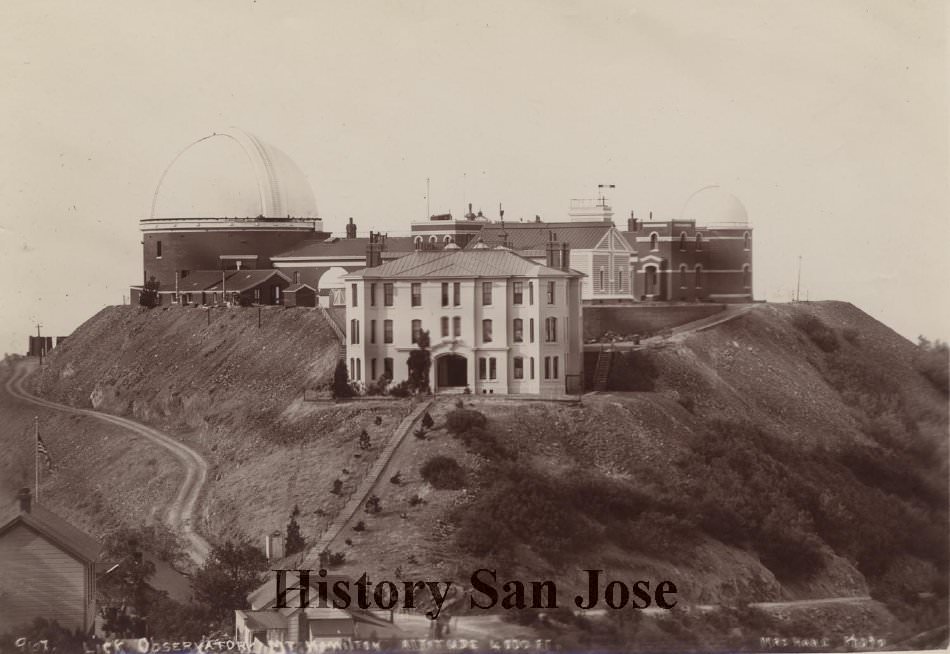

























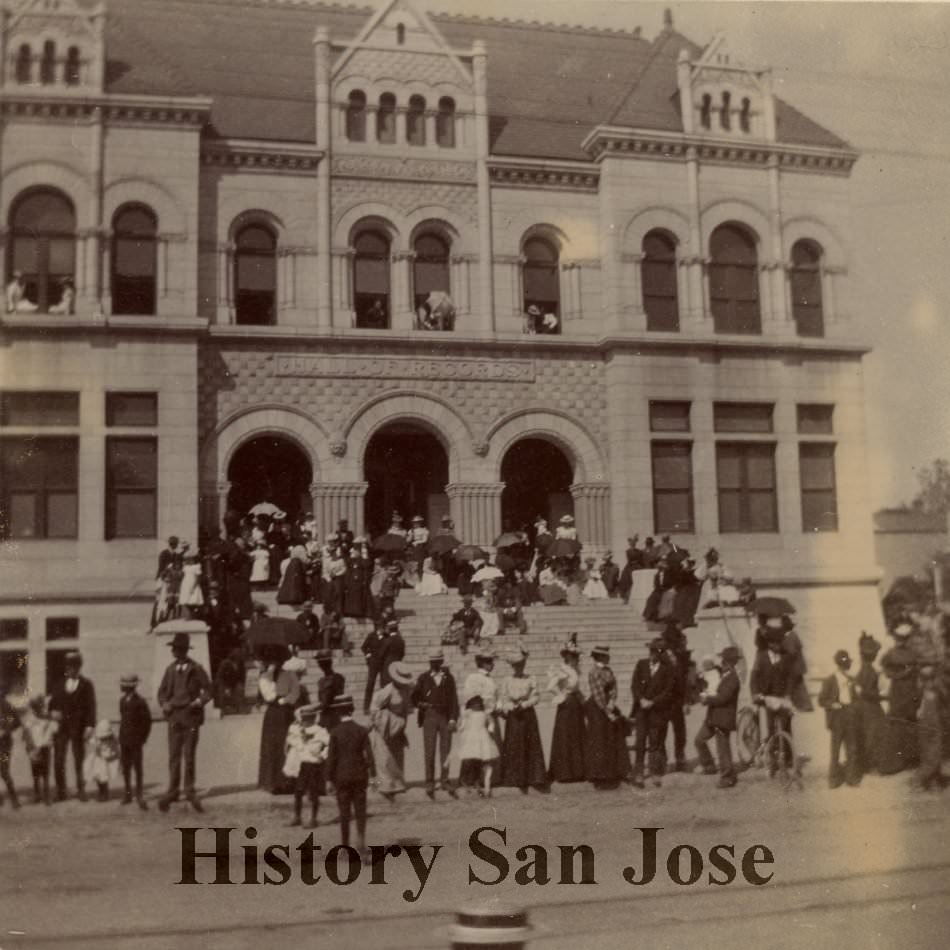

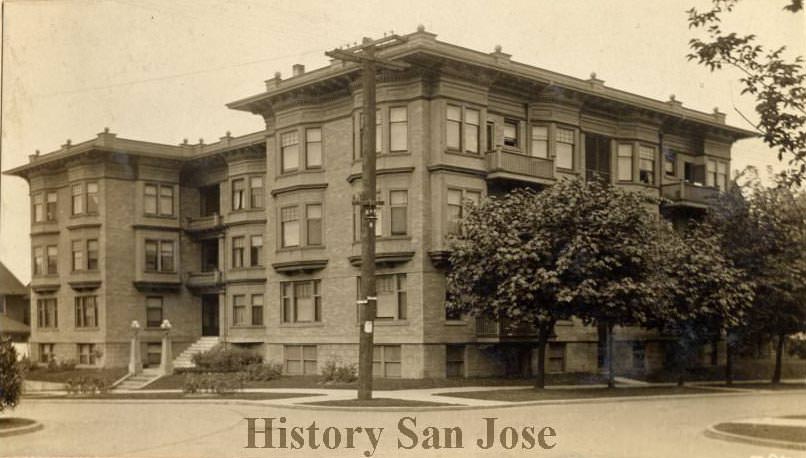





























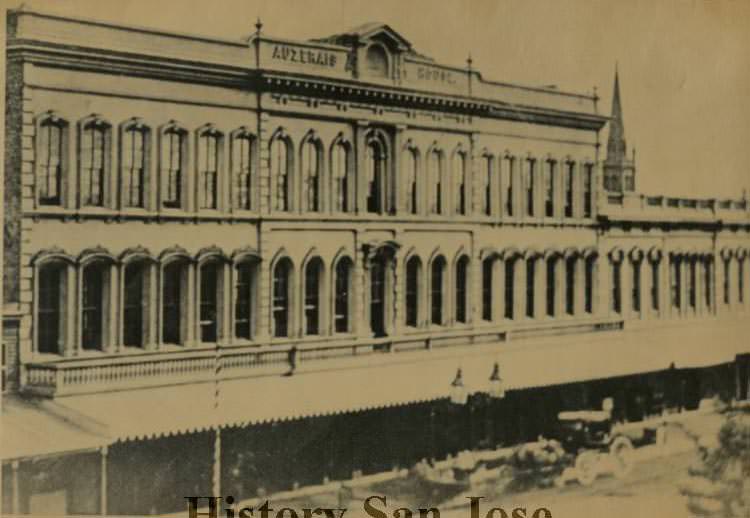













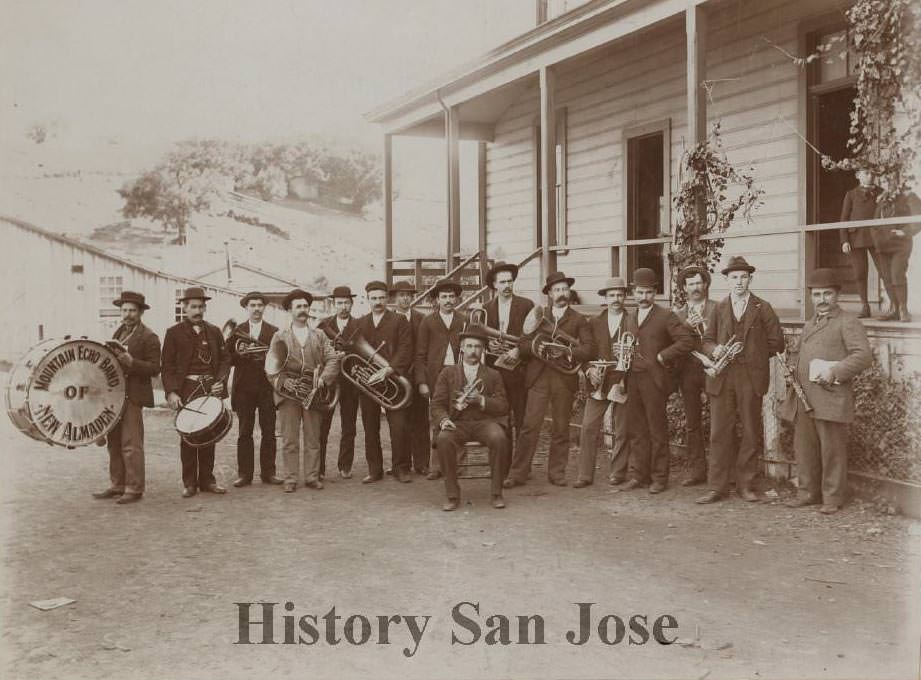


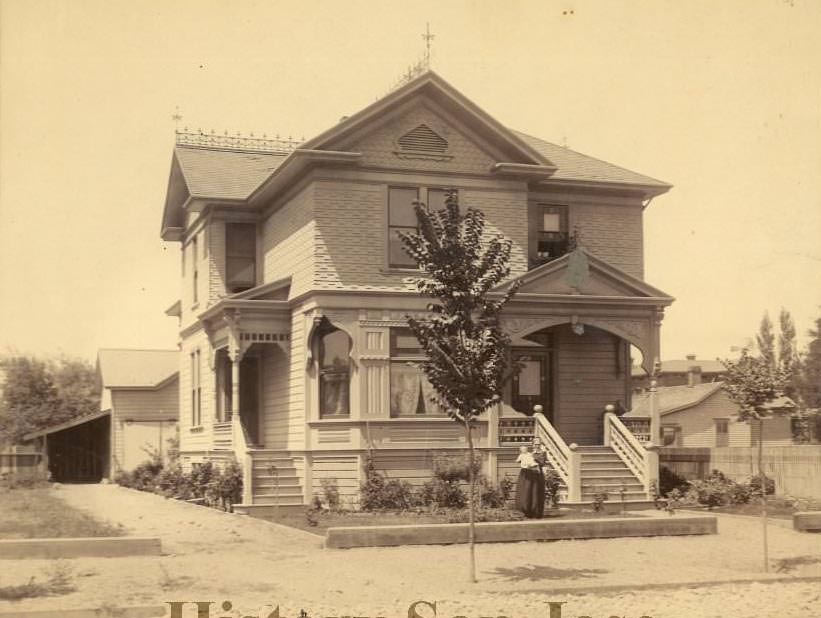























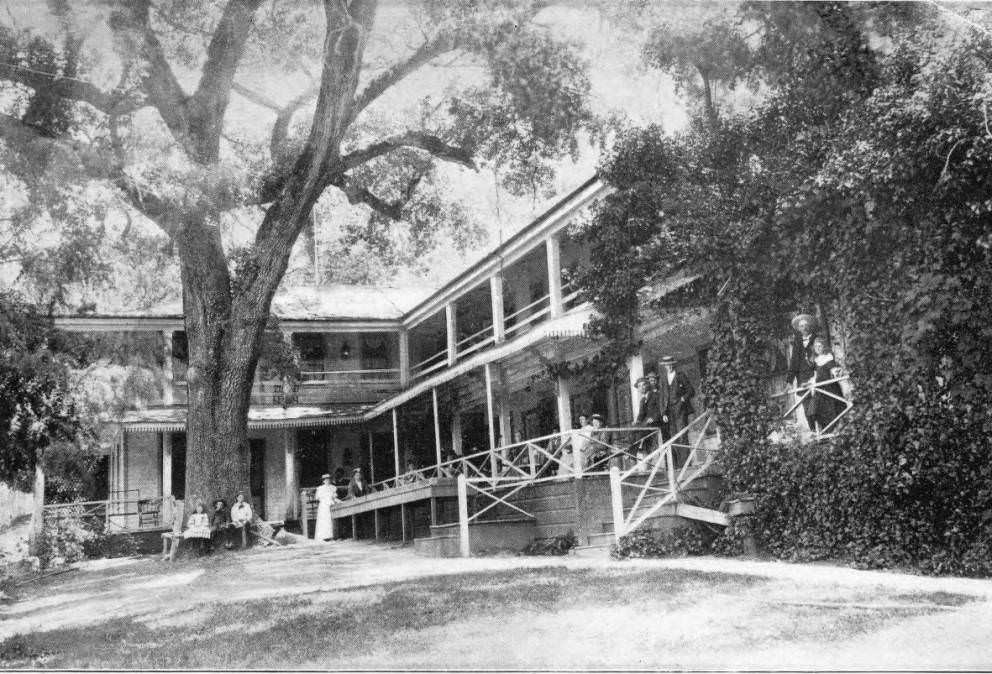


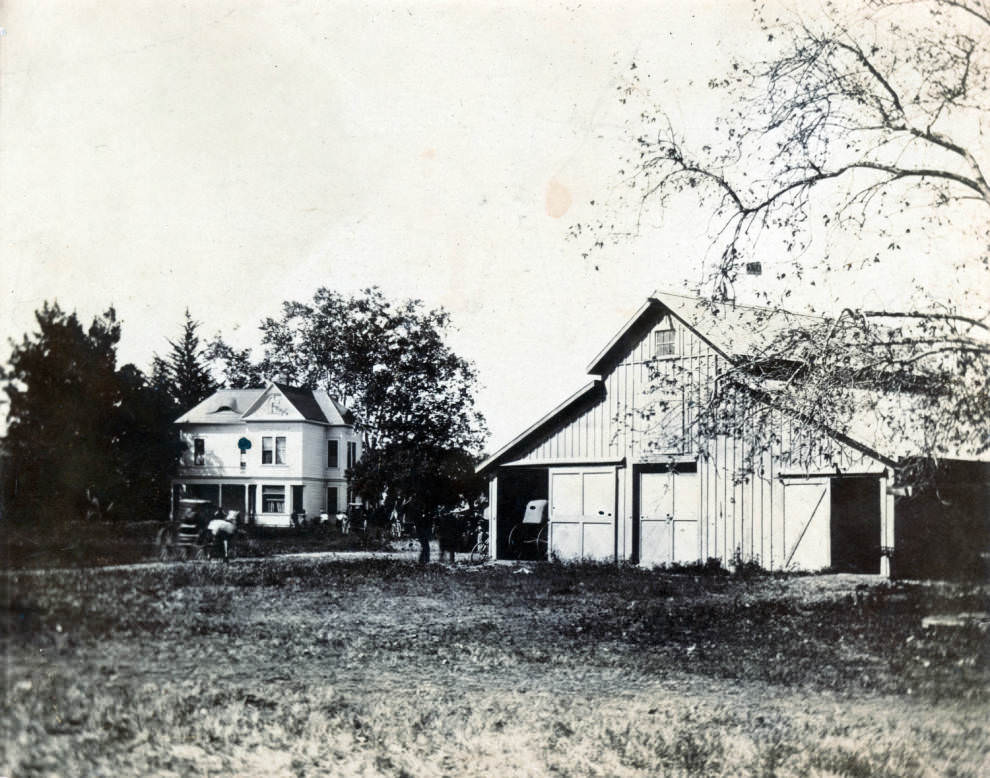





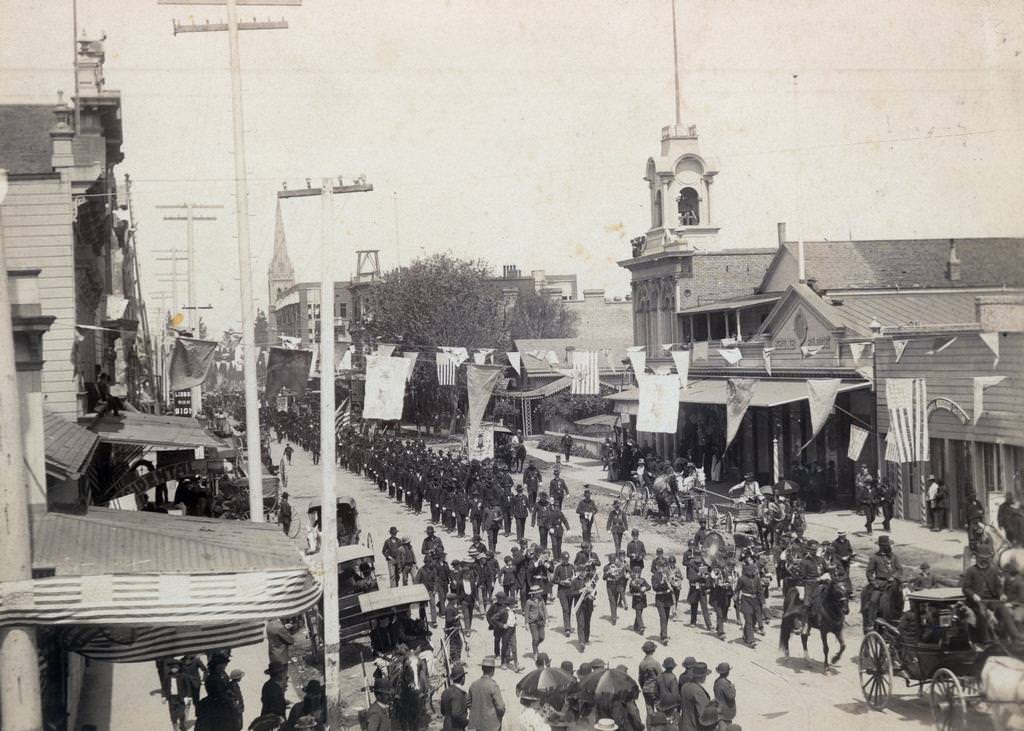


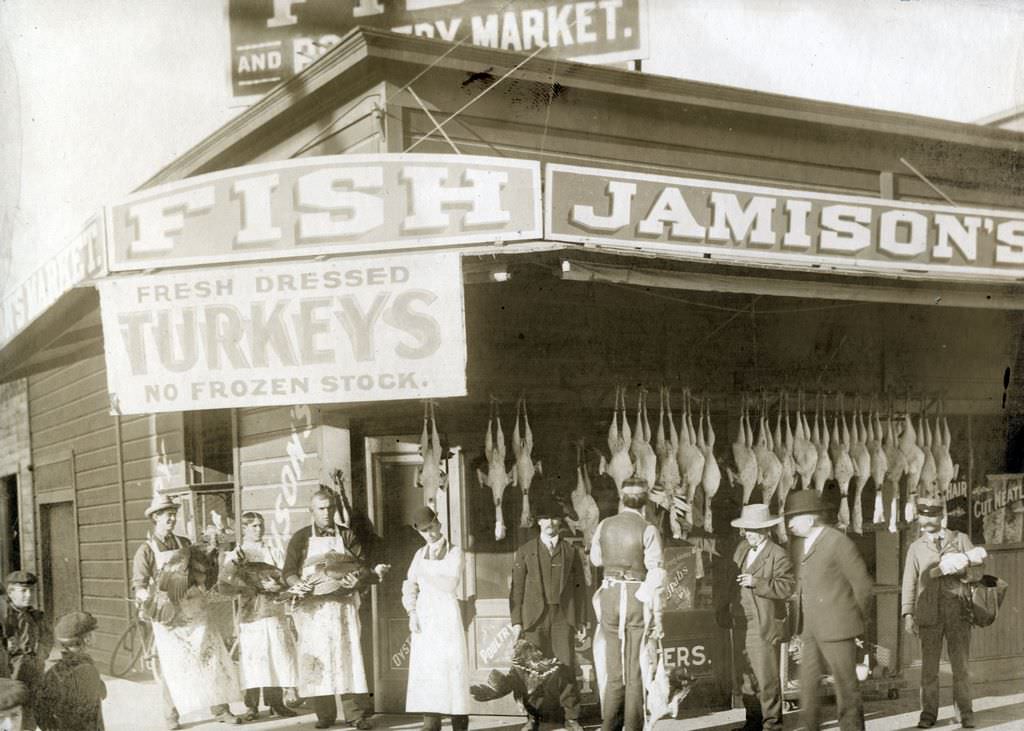






Thanks for sharing. On McLaughlin and Tully there are still a few farmhouses with septic tanks and water tank house w/o windmill. People sleep inside tank room today still.
I live right off of McLaughlin between Tully and Capitol Expressway. One of my friends houses when I was a kid was right behind one of the farmhouses on McLaughin and Candia. We used to play in her backyard and the tower from the old house was right on the other side of her fence and we would laugh about how it was “haunted”.
Also, what is now the Evergreen Adult Development Center on McLaughlin used to be a school called Tower Academy. I went to an after school program there as a kid because my mom was working there for about a year. The big huge tower on the campus was occupied by the janitor there at the time. So many years later I drive by it every day and wonder if someone still lives up there, and what their view must be like.
In downtown by 13th and Santa Clara there are still some homes with a water tower south of I-101. Illegal ADU.
SJPD had a horse patrol boarding staples behind Fairground. Now newer housings.
I believe they still keep the horses in stables about a half mile from where I live behind Stonegate Elementary school, off Kenoga Drive and Tully.
Probably has a more bumping downtown back then.
Interesting photos of a few buildings, but I was hoping to see images of the valley from the foothills, to illustrate the scale of all that has been built since then.
There was no Chinatown. They burned it down three times and foreclosed on the properties twice. The only safe place for Chinese was Heinlinville, who was a European American giving opportunities to Chinese workers and what is now Japantown. Japantown was abandoned due to internment of Japanese Americans. Chinese settled there. Japantown was abandoned by the original Japanese after they were freed from internment. The current incarnation is from the flood of Vietnamese and Filipino refugees.
I worked at Winchester for 4 years and never saw that photo of Sarah’s bedroom! How cool!!